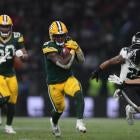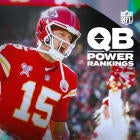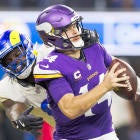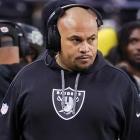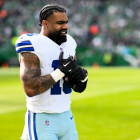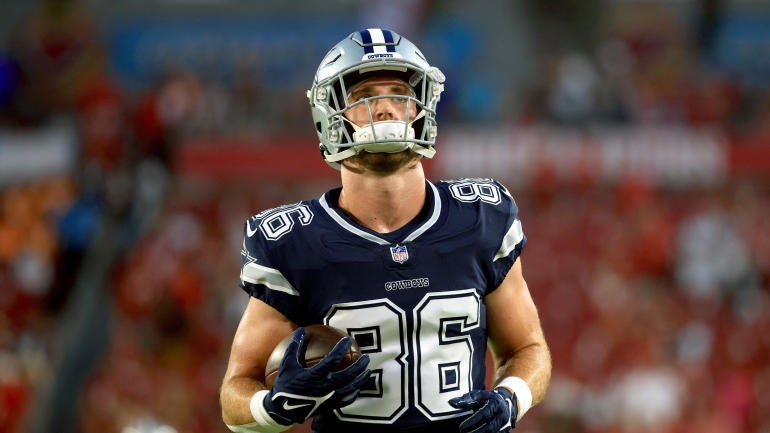
The clock is ticking for teams to sign players given the franchise designation to a long-term deal. The deadline for franchise players to sign multiyear contracts is July 15 at 4 p.m. ET. After the deadline passes, players with franchise tags are prohibited from signing long-term deals until the end of the regular season on Jan. 8, 2023.
Eight players received franchise player designations this year. Four have already signed long term. The two franchised wide receivers quickly agreed to deals after the 2022 league year started on March 16. The Buccaneers gave Chris Godwin a three-year, $60 million deal with $40 million fully guaranteed despite him tearing the ACL and MCL in his right knee late in the 2021 regular season.
The Raiders acquired Davante Adams from the Packers for 2022 first- and second-round picks in a sign-and-trade transaction. Adams signed a five-year, $140 million contract containing $65.67 million in guarantees. The maximum value of Adams' contract is $141.25 million because of an annual $250,000 Pro Bowl incentive. Adams' deal is really $67.5 million over three years because there's $72.5 million in the last two years. The chances of Adams playing 2025 and 2026 for $36.25 million each when he's 32 and 33 years old are remote.
The Jaguars signed left tackle Cam Robinson to a three-year, $52.75 million contract with $33 million fully guaranteed. The deal is worth as much as $54.25 million with incentives.
The Browns made David Njoku the NFL's fifth-highest-paid tight end by average yearly salary at $13,687,500 per year. Njoku's four-year, $54.75 million contract has $28 million in guarantees. The maximum value of the deal is $56.75 million thanks to $500,000 of annual incentives based on All-Pro selections.
Here's a look at the situations of the four franchise players who haven't signed long term.
Orlando Brown, OT, Chiefs
There wasn't any doubt that the Chiefs were going to franchise Brown for $16.662 million. The Chiefs couldn't risk Brown potentially being a one-year rental by becoming a free agent given the draft capital required to obtain him from the Ravens shortly before the 2021 NFL Draft.
Brown forced a trade because he wanted to be a left tackle, which wasn't possible in Baltimore because of All-Pro Ronnie Stanley. The Chiefs gave up their 2021 first-round pick (31st overall), a 2021 third-round pick, a 2022 fourth pick and a 2022 fifth-round selection to the Ravens for Brown, a 2021 second-round pick and a 2022 sixth-round pick.
Brown validated his move from right tackle to left tackle with a selection to the Pro Bowl last season. The Chiefs are likely going to join the ranks of teams paying a premium financially when a long-term deal for a player who had remaining time on his contract isn't done in connection with a trade involving significant draft capital.
Brown, who recently hired Michael Portner of the Delta Sports Group as his new agent, has expressed optimism about his signing. Any long-term deal will surely put Brown in the $20 million-per-year offensive lineman club, which currently has three members. Left tackles Trent Williams, David Bakhtiari and Laremy Tunsil have deals with the 49ers, Packers and Texans, averaging $23.01 million, $23 million and $22 million per year, respectively.
Jessie Bates, S, Bengals
Bates reportedly has no intention of playing under his $12.911 million franchise tag. Sitting out the season if a long-term deal isn't reached by July 15 would be surprising. The franchise tag is more than twice as much what Bates made from his four-year rookie contract that expired after the 2021 season. Bates' career earnings to date from his NFL player contract are just over $6.225 million.
It is a rarity for franchise players to miss a season. Last time it happened before Steelers running back Le'Veon Bell in 2018 was with Chiefs defensive lineman Dan Williams in 1998.
The Bengals probably view the $14 million per year that Marcus Williams, who was designated as a franchise player by the Saints in 2021, received from the Ravens on a five-year deal in free agency this year as indicative of Bates' value. Bates likely was looking for a deal in the same vicinity as Jamal Adams, who reset the safety market with a four-year, $70 million contract extension, averaging $17.5 million per year and worth up to $72 million through incentives and salary escalators from the Seahawks last August.
That was before the recent developments in the safety market. The Steelers making Minkah Fitzpatrick the league's highest-paid safety on a four-year extension, averaging $18.247 million per year with $36 million fully guaranteed, only complicates matters.

Pick Six Newsletter
Crafted By The Best NFL Experts
Get the day's big stories + fun stuff you love like mock drafts, picks and power rankings.
Thanks for signing up!
Keep an eye on your inbox.
Sorry!
There was an error processing your subscription.
Dalton Schultz, TE, Cowboys
Schultz quickly signed his $10.931 million tender after the Cowboys made him a franchise player in March. Frustrated by the slow pace of negotiations for a new contract, Schultz skipped the final part of organized team activities. He avoided being fined $95,877 by showing up for the mandatory June minicamp.
The Cowboys can't be happy about the Njoku deal. Njoku's $13,687,500 average per year should serve as a salary floor for Schultz especially since Njoku doesn't measure up to him statistically.
Schultz had a career year in 2021 with 78 catches, 808 receiving yards and eight touchdowns. He was more productive last season in 17 games than Njoku was over the last two seasons combined in the 29 games he played. Njoku caught 55 passes for 688 yards with six touchdowns. Schultz produced 23 more receptions, 120 more receiving yards and two more touchdown catches than Njoku.
Schultz and the Cowboys reportedly aren't close to reaching a deal. Playing the franchise tag game hasn't been the most economical move for the Cowboys. The last two times Dallas had someone play a season under a franchise tag, it cost them more to eventually sign the players long term. The same concept would likely apply to Schultz with a productive 2022 season.
The Cowboys definitely wouldn't have needed to sign defensive end DeMarcus Lawrence to a five-year, $105 million contract, averaging $21 million per year, if a deal had been done in 2018. At the July 15 long-term deal deadline, the $20 million-per-year non-quarterback didn't exist.
Dak Prescott doesn't sign a $40 million contract in March 2021 with an agreement reached in July 2020. There's a good chance Prescott's deal would have been under the $35 million-per-year extension Russell Wilson signed with the Seahawks in 2019. Deshaun Watson didn't get his $39 million-per-year extension from the Texans, which was seemingly an important data point for Prescott, until right before the 2020 regular season started.
Mike Gesicki, TE, Dolphins
All has been quiet on the Gesicki contract front. Unless something changes, Gesicki is going to play under the $10.931 million franchise tag he signed in March.
Similar to the Cowboys and Schultz, the Browns didn't do the Dolphins any favors with Njoku's contract. Gesicki's 2021 production was also better than Njoku's over the last two seasons. His 73 catches and 780 receiving yards, both career highs, were 18 more and 92 more, respectively, than Njoku.
There's a potential dynamic with Gesicki that doesn't exist with Schultz. Gesicki could follow in Jimmy Graham's footsteps and file a grievance to be classified as wide receiver instead of a tight end with his franchise player designation. The difference in the two tags is $7.488 million as the 2022 wide receiver number is $18.419 million.
Under the NFL Collective Bargaining Agreement, franchise tags are determined by the position where the player participated in the most plays during the prior season. According to Pro Football Focus, 54.78% of Gesicki's 827 offensive snaps in 2021 were in the slot, 11.97% were as an in-line tight end and 30.74% were out wide.
Graham lost his grievance in 2014. Arbitrator Stephen Burbank ruled that Graham was a tight end when lined up in the slot within 4 yards of an offensive lineman, which he did on more than 50% of his plays with the Saints in 2013.








